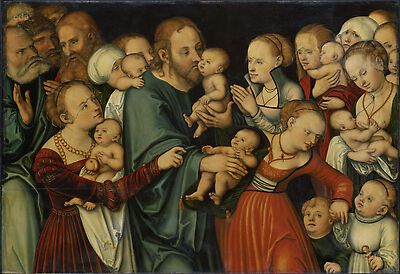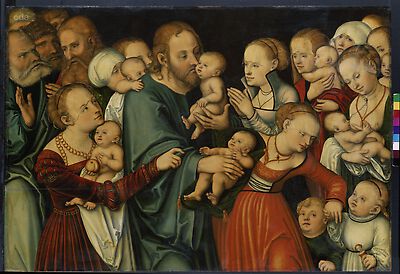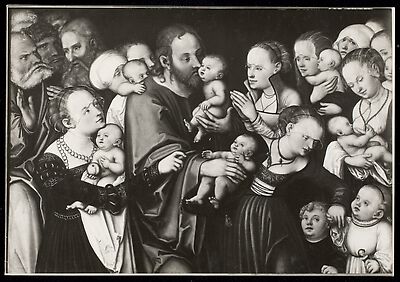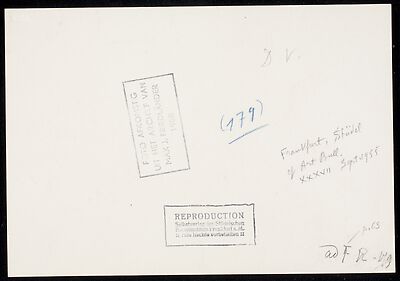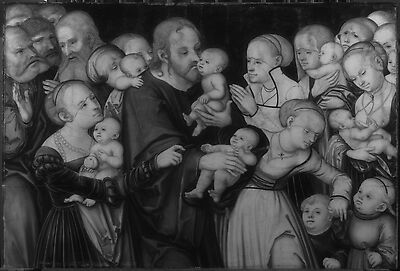| Exhib. Cat. Düsseldorf 2017 |
208 |
No. 114 |
|
| Editor | Gunnar Heydenreich, Daniel Görres, Beat Wismer |
|---|
| Title | Lucas Cranach der Ältere. Meister - Marke - Moderne. [anlässlich der Ausstellung "Cranach. Meister - Marke - Moderne", Stiftung Museum Kunstpalast, Düsseldorf, 08. April 2017 - 30. Juli 2017] |
|---|
| Place of Publication | Munich |
|---|
| Year of Publication | 2017 |
|---|
|
| Görres 2017 B |
48, 49 |
114 |
Fig. 4 (detail) |
|
|
| Price 2017 |
12, 19 |
|
Fig. p. 12, Fig. 5 |
| Author | David H. Price |
|---|
| Title | Lucas Cranach e la Riforma |
|---|
| Publication | in Francesca de Luca, Giovanni Maria Fara, eds., I volti della Riforma. Lutero e Cranach nelle collezioni medicee , Exhib. Cat. Florence, 2017 |
|---|
| Place of Publication | Florence, Milan |
|---|
| Year of Publication | 2017 |
|---|
| Pages | 12-27 |
|---|
|
| Exhib. Cat. Gotha, Kassel 2015 |
200, 201 |
56 |
Pl. p. 201 |
| Editor | Julia Carrasco, Justus Lange, Benjamin D. Spira, Timo Trümper, Stiftung Schloss Friedenstein, Gotha |
|---|
| Title | Bild und Botschaft. Cranach im Dienst von Hof und Reformation, [Gotha, Herzogliches Museum; Kassel, Gemäldegalerie Alte Meister, Schloss Wilhelmshöhe] |
|---|
| Place of Publication | Heidelberg |
|---|
| Year of Publication | 2015 |
|---|
|
| Spira 2015 |
59 |
|
|
| Author | Benjamin D. Spira |
|---|
| Title | Lucas Cranach, der Maler Luthers. Der Hofmaler und der Reformator - Bindung, Bilder und Bedeutung |
|---|
| Publication | in Julia Carrasco, Justus Lange, Benjamin D. Spira, Timo Trümper, Stiftung Schloss Friedenstein Gotha and Museumslandschaft Hessen Kassel, eds., Bild und Botschaft. Cranach im Dienst von Hof und Reformation, [Exhib. Cat. Gotha, Kassel] |
|---|
| Place of Publication | Heidelberg |
|---|
| Year of Publication | 2015 |
|---|
| Pages | 51-62 |
|---|
|
| Brinkmann 2007 |
22 |
|
|
| Author | Bodo Brinkmann |
|---|
| Title | Das Lächeln der Madonna. Lucas Cranach und die Folgen |
|---|
| Publication | in Bodo Brinkmann, ed., Cranach der Ältere, Exhib. Cat. Frankfurt |
|---|
| Place of Publication | Ostfildern |
|---|
| Year of Publication | 2007 |
|---|
| Pages | 17-27 |
|---|
|
| Exhib. Cat. Frankfurt 2007 |
214-215 |
50 |
p. 215 |
| Editor | Bodo Brinkmann |
|---|
| Title | Cranach der Ältere, [Frankfurt, Städel Museum, 23 Nov 2007 - 17 Feb 2008] |
|---|
| Place of Publication | Ostfildern |
|---|
| Year of Publication | 2007 |
|---|
|
| Koepplin 2007 B |
66, 70, 71 |
|
|
| Author | Dieter Koepplin |
|---|
| Title | Cranachs Bilder der Caritas im theologischen und humanistischen Geiste Luthers und Melanchthons |
|---|
| Publication | in Bodo Brinkmann, ed., Cranach der Ältere [Exhib. Cat. Frankfurt] |
|---|
| Place of Publication | Ostfildern |
|---|
| Year of Publication | 2007 |
|---|
| Pages | 63-79 |
|---|
|
| Cat. Frankfurt 2005 |
226-234 |
|
|
| Author | Stephan Kemperdick, Bodo Brinkmann |
|---|
| Editor | Städelsches Kunstinstitut |
|---|
| Title | Deutsche Gemälde im Städel 1500 - 1550 |
|---|
| Place of Publication | Mainz |
|---|
| Year of Publication | 2005 |
|---|
|
| Cat. Frankfurt 1999 |
29 |
|
pl. 21 |
| Author | Bodo Brinkmann, Jochen Sander |
|---|
| Title | Deutsche Gemälde vor 1800 im Städel |
|---|
| Place of Publication | Frankfurt |
|---|
| Year of Publication | 1999 |
|---|
|
| Andersson 1981 |
59 |
|
|
| Author | Christiane D. Anderson |
|---|
| Title | Religiöse Bilder Cranachs im Dienste der Reformation |
|---|
| Publication | in L.W. Spitz, ed., Humanismus und Reformation als kulturelle Kräfte in der Deutschen Geschichte |
|---|
| Place of Publication | Berlin, New York |
|---|
| Year of Publication | 1981 |
|---|
| Pages | 43-76 |
|---|
|
| Friedländer, Rosenberg 1979 |
113 |
217A |
|
| Author | Max J. Friedländer, Jakob Rosenberg |
|---|
| Editor | G. Schwartz |
|---|
| Title | Die Gemälde von Lucas Cranach |
|---|
| Place of Publication | Basel, Boston, Stuttgart |
|---|
| Year of Publication | 1979 |
|---|
|
| Brücker 1963 |
211 |
|
|
| Author | Wolfgang Brücker |
|---|
| Title | Conrad Faber von Creuznach |
|---|
| Series | Schriften des Historischen Museums Frankfurt am Main |
|---|
| Volume | 11 |
|---|
| Place of Publication | Frankfurt |
|---|
| Year of Publication | 1963 |
|---|
|
| Kibish 1955 |
196-203 |
|
|
| Author | Christine O. Kibish |
|---|
| Title | Lucas Cranach's Christ Blessing the Children. A Problem of Lutheran Iconography |
|---|
| Journal | The Art Bulletin |
|---|
| Issue | 37 (1955) |
|---|
| Year of Publication | 1955 |
|---|
| Pages | 196-203 |
|---|
|
| Lerner 1953 |
117 |
|
|
| Author | Franz Lerner |
|---|
| Title | Gestalten aus der Geschichte des Frankfurter Patrizier-Geschlechts von Holzhausen |
|---|
| Place of Publication | Frankfurt |
|---|
| Year of Publication | 1953 |
|---|
|
| Friedländer, Rosenberg 1932 |
63 |
|
|
|
|
| Weizsäcker 1923 |
50 |
|
|
| Author | Heinrich von Weizsäcker |
|---|
| Title | Die Kunstschätze des ehemaligen Dominikanerklosters in Frankfurt a. M. |
|---|
| Volume | 1, 2 |
|---|
| Place of Publication | Munich |
|---|
| Year of Publication | 1923 |
|---|
| Link |
https://doi.org/10.11588/diglit.61862 |
|
| Benkard 1911 |
col. 485 |
|
|
| Author | Ernst Benkard |
|---|
| Title | Das Holzhausen-Kabinett im Städelschen Institut |
|---|
| Journal | Kunstchronik |
|---|
| Issue | N. F. 22 |
|---|
| Year of Publication | 1911 |
|---|
| Pages | col. 481-486 |
|---|
|
| Rieffel 1911 |
346 |
|
|
| Author | Franz Rieffel |
|---|
| Title | Die Freiherrlich von Holzhausensche Gemäldesammlung in der Städelschen Galerie (zugleich ein Beitrag zur Geschichte der mittelrheinischen Malerei im XVI. Jahrhundert, namentlich in Frankfurt) |
|---|
| Journal | Monatshefte für Kunstwissenschaft |
|---|
| Issue | 4 |
|---|
| Year of Publication | 1911 |
|---|
| Pages | 341-352 |
|---|
|
| Michaelson 1902 |
106, 136 |
|
|
| Author | Hedwig Michaelson |
|---|
| Title | Lukas Cranach der Ältere. Untersuchung über die stilistische Entwicklung seiner Kunst |
|---|
| Place of Publication | Leipzig |
|---|
| Year of Publication | 1902 |
|---|
|
| Schuchardt 1851 C |
60 |
302 |
|
|
|
| Kirchner 1818 |
335 |
|
|
| Author | Anton Kirchner |
|---|
| Title | Ansichten von Frankfurt a. M. |
|---|
| Volume | 1 |
|---|
| Place of Publication | Frankfurt |
|---|
| Year of Publication | 1818 |
|---|
|
| Goethe 1814-1815 |
353 |
|
|
| Author | Johann Wolfgang von Goethe |
|---|
| Editor | Eduard von der Hellen |
|---|
| Title | Kunst und Altertum am Rhein, Main und Neckar. 1814 und 1815 |
|---|
| Series | Goethe Werke. Auswahl in 15 Bänden |
|---|
| Volume | 13 |
|---|
| Place of Publication | Stuttgart, Berlin |
|---|
| Year of Publication | 1815 |
|---|
| Pages | 329-401 |
|---|
|
